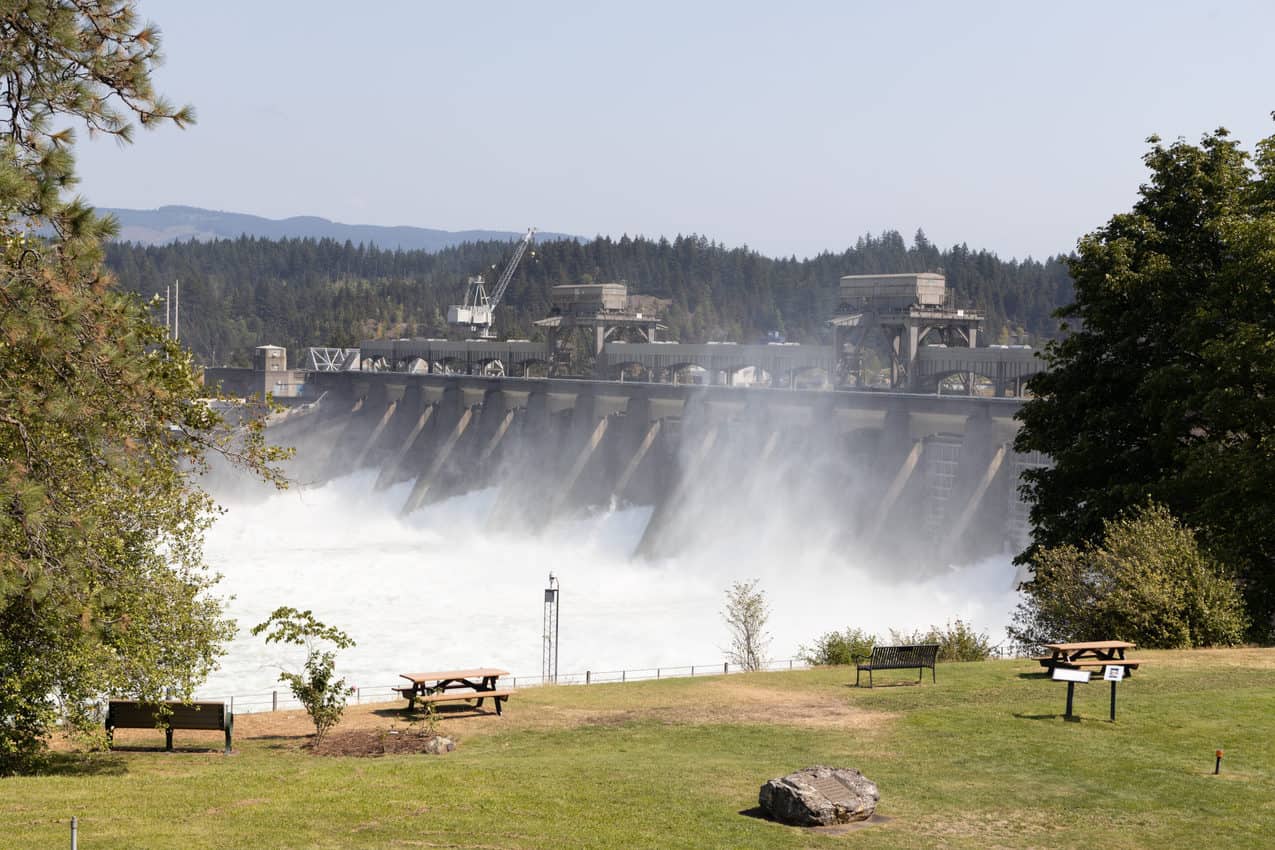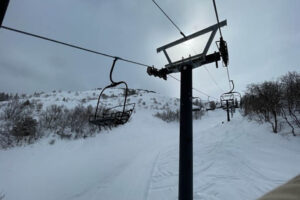Digging Up The Past in Utah’s Flaming Gorge
By David McIntire
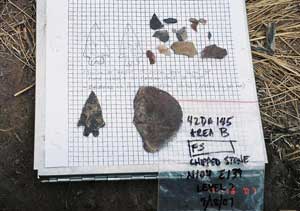
I was born in the 70s but grew up in the 80s, which means that TV, movies, music and all forms of pop culture have always played a role of outsized importance in my life.
So I guess it shouldn’t come as much of a surprise that one of my great heroes in life was a movie character. He was cool, composed, always partaking of some amazing adventure and ending up with the girl.
He was also, for most of us, the first glimpse of a small, obscure profession that isn’t encountered much in the real world these days. Sure, he wasn’t real, but for an entire generation, no single person has ever so embodied an entire profession as he did.
Therefore, as I kneel in a cactus, covered in dirt from head to toe, in the 90 degree heat of a mid-summer day in northern Utah, there is clearly only one person to blame.
Damn you Indiana Jones.
Passport in Time
As you may remember from that scene where hundreds of people are digging in Raiders of the Lost Ark, archaeology is a labor intensive enterprise. Unlike in Indy’s world however, there are few real riches to be discovered that would provide motivation for large numbers of people to dig in the heat.
Faced with this problem, the US Forest Service came up with a unique resolution to the problem of finding budget to support the masses of people necessary to properly conduct a dig.
They decided not to find the budget. Instead, Passport in Time was born.
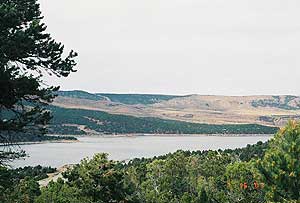
Passport in Time (or PIT) allows anyone to apply to help on digs throughout the county, throughout the year. The leader of each program reviews all applicants and selects the people he needs, who happily come from across the country to provide free manual labor.
This summer I channeled my inner-Indy and joined a crew working at Dripping Springs in Utah.
Discovering Flaming Gorge
Flaming Gorge was named by John Wesley Powell as he drifted the Green River on his way to being the first known (i.e. white) man to float the Colorado River through the Grand Canyon.
Its name was meant to commemorate the bright red stone that made up much of the walls of the valley. At least I assume they were walls of a canyon.
As of 1964, the Flaming Gorge Dam turned the valley into a reservoir, so picturing the towering walls of a canyon with a river hundreds of feet below the current water level is a little difficult.
The honorific Flaming Gorge name took on an ironic name when the Mustang forest fire swept through the area just northeast of the water in 2002.
With a barren landscape left from the fire, an increased number of Native American artifacts began to emerge leading to the first excavation at Dripping Springs in 2004.
In 2007, Robert Nash decided to return to the area and expand the digging begun three years earlier.
Nash, a PhD candidate from UC Davis, is trying to determine why and how the Fremont people began growing corn in the region – an area at roughly 6,000 feet elevation and at the very northern edge of land with a growing season long enough to sustain the crop. We are here to help him.
On a Monday in July, we all meet at the Flaming Gorge Dam Visitor’s Center. There are five of us volunteers, Robert and another student from Davis, Liz.
After introductions, we hop in our cars and in a scene vaguely reminiscent of the movie Twister, our caravan heads north away from the deep clear lake and sheer red cliffs and past the town of Dutch John (town being a liberal definition for two gas station/convenience store/fishing guides, a few homes and a church).
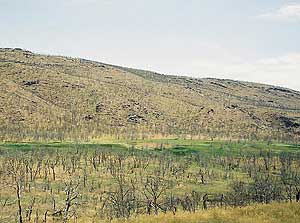
As we wind back away from the lake, the landscape changes from the high desert meets mountain near the lake (think pine trees and cacti) to the other-worldly vista familiar to any westerner as hillsides that have been victimized by fire.
Skeletal trees stand intermittently across the hillside, but their partially white, partially blackened trunks are not showing any new growth. The land between the trees remains free of much vegetation; just some sparse, brown grass grows among the still visible pieces of charcoal.
It takes conscious effort to remember that this fire took place five years ago.
After cresting a hill, a strange stripe of green runs across the carcass of the hillside to our north. This is Dripping Spring and as we near it, we pull over.
The fresh water seeping from the interior of the hill has enabled a flash of color to rebound from the burn and also acted as a beacon to people searching the area for a water source hundreds of years ago.
The excavation is actually comprised of two sites. One is next to the original 2004 site and the other about 25 yards away where a formation of rocks had caught Robert’s eye while here surveying.
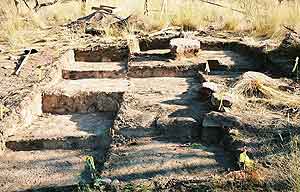
I move to Site B with Robert and another volunteer. As we approach there appear to be stair steps cut into the hillside, as if the excavation were actually slowly revealing that the hill is in fact a giant Mayan palace.
These are actually meter by meter squares by which an excavation progresses (archaeology is a science after all).
On that first morning, I am assigned one of the squares (with, yes, a cactus located at one corner) and told to remove the top 10 centimeters of dirt using trowels. We loosen the dirt and scoop it into buckets. When the buckets are full, we haul them to screens built on two legs and dump the dirt; sifting until larger, chunky items remain that we cull through looking for anything that appears to be man-made.
Having never done this before, not entirely 100% sure what to look for and afraid I will dismiss the piece that will constitute the one piece of information needed to understand these ancient people, I progress slowly.
Over the next week, the biggest changes in my daily life are the square of dirt on which I work and the speed at which I sift through the loosened earth.
While I adjust to the daily toil of digging in the dirt, our team starts to lose members faster than the group that wandered Germany trying to save Private Ryan.

Tuesday morning, my volunteer partner on Site B is a no-show. Wednesday morning, Site A loses one of its volunteers. Thursday, Sylvia, a retired oil company archaeologist on Site A is stricken by a stomach bug.
We have dropped from five to two in three days (though Sylvia will make it back on Friday). Progress on the site slows as our man-power keeps dropping.
Happy Hour – Flaming Gorge Style
After knocking off from the site at 4 pm, I take advantage of the free time and to check out what Flaming Gorge has to offer.
Tuesday evening I return to my base camp, throw my mountain bike in the car and head west away from reservoir, climbing up out of the broad valley in which it sits. Turning off of State Road 44, I pull into a parking lot.
As I prep my bike, panoramic views of the lake dominate the view to the east.
I mount my bike and head off down the Canyon Rim trail. Fairly flat (a benefit for those of us not quite in peak condition), the trail wanders through the forest and meadows dominating the ridges above the lake.
Other than the never-ending jostling received from the rocks making up the trail (think of driving on a road that is constant potholes) that make me wish I had added rear suspension to my hard tail bike, the ride is an enjoyable one.
Three and a half miles in, I reach my turnaround point and return on the same trail back to my car. A quick seven-mile ride is the perfect way to stretch out the kinks in the legs that come from squatting in the dirt for eight hours.

Wednesday night, I decide to take advantage of the lake itself. Grabbing a fishing rod, I drive to the north side of the lake.
Skirting the edge of Sunny Cove, the flat ground quickly gives way to steep red rocks that drop directly down into the water plummeting out of sight.
Tossing lures into the blue abyss, below my rocky perch, I quickly feel the irregular tug-tug of a small fish and land a small rainbow trout. It is always a relief to catch that first fish that ensures that the trip will not be a total bust.
Working around the point at the end of the bay along the shore, I finally get another hit and a few moments later reel in a smallmouth bass. A somewhat surprising member of the local fish population, smallmouths are more of a warm water fish than trout, but apparently have found a home here in the waters of northern Utah.
As the sun begins to drop and my stomach grumbles, I pack up my rod and head back to the car for the short commute back to camp.
Home Sweet Home
While it is convenient to label any time spent living in a tent, as ‘roughing it,’ my stay at Deer Run campground stretches that definition to its limit.
My quiet camp site comes with a picnic table, fire pit and adequate shade to actually feel fairly private, even when the family next door sits around their campfire talking.

A short walk down the paved road that loops through the campground is a full bathroom and shower facility that is cleaned each day.
While I don’t exactly have all the comforts of home, a completely functioning bathroom and a shower to wash off the day’s dirt definitely removes a bit of the hard-core factor from this trip.
‘Oh My God’
By Wednesday afternoon we have settled into a routine, with Robert and me at Site B and Liz working with Sylvia at Site A along with Richard, a farmer from Washington who discovered archaeology late and fell so hard for it, that he returned to school to get an archaeology degree.
The site has not yet yielded much in the form of memorable pieces or critical information, so as Robert and I sift our latest scraping, it comes as a surprise to hear a loud ‘Oh My God!’ come from Sylvia at the other site.

Dubious that anything short of the Ark of the Covenant really warrants the yelling, Robert and I walk over to find the crew huddled around a large object in Sylvia’s hand. It looks to my untrained eye like what we typically think of as an arrowhead, though much bigger (probably 4-5 inches long) and in perfect condition.
It doesn’t have the notches at the end that would be necessary to tie the head to a pole or arrow so Robert labels it a knife. As Sylvia begins to make extensive notes and drawings of the piece, I return to site B and keep working.
30 minutes later, as I haul another bucket of dirt to the screens, I glance down at a bucket before dumping it. There, sitting on top of the dirt, as if placed by some unseen hand is a huge perfectly formed arrowhead (or projectile point as the pros call them).
Smaller than Sylvia’s knife but with a split tail and telltale notches at the back, it is as perfect an artifact as I could ever dream of finding.
This is the moment I had always dreamt of: the moment of discovery that bonds us with a people that came hundreds of years before us, giving us at least a small window into their existence.
Thank you, Indiana Jones.
Logistics:
Passport in Time updates their new projects throughout the year. You can scout prospective projects and apply at their website.
For more information on Flaming Gorge National Pack click here.
For more information on the Native Americans of the northern Utah area, click here.
For reservations at any US Forest Service campground (including Deer Run) you can use their online reservation tool.

David McIntire lives in Denver. He has previously written for GoNomad about searching for conch in the Turks and Caicos Islands. For the record, he did not show up the first day at the archaeological site in a leather jacket and fedora.
- Saudi Arabia Might Be Your Next Getaway Spot - April 23, 2024
- Mongolia, the Land of Eternal Blue Sky - April 20, 2024
- These 9 U.S. National Parks Require Reservations in 2024 - April 17, 2024


